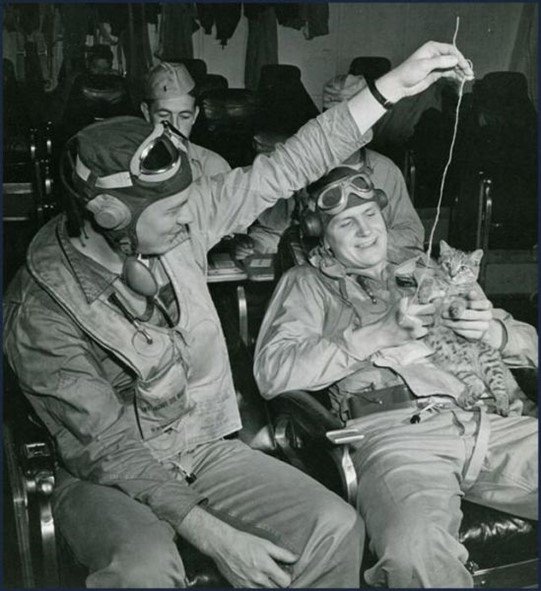Furry and Fearless
It wasn’t uncommon for a serviceman to pick up and befriend a stray cat or dog on the war front. Dogs were used as pack animals, and sometimes trained to carry messages. As can be seen here, four-footed friends always brought a smile to the faces of the men who were reminded of a special pup or kitten they had left “back home”.

A sailor with his “buddy”, 1945.

Grinning, U.S. Marine Private Francis Hall, stationed in Iwo Jima, poses with his Doberman dog.

Relieving the stress of their recent mission, this group of airmen relax . . . with a kitten.

Iwo Jima war dog, “Prince”, is given instructions by his master, U.S. Marine Corporal Virgil W. Burgess, to carry a message to another foxhole.

These servicemen are all smiles about these kittens.

Dogs were buddies, too. This war dog is being treated by medical personnel.

U.S.M.C. Corporal Edward Burckhardt just rescued this kitten from the wastelands of Mount Suribachi; here he is playing with it in a special moment captured by a photographer.

Pack dogs, like the one shown here, were bred and trained for packing. The dogs had to meet several qualifications, such as a specific weight, strong legs, and no swayback.

“Salty” is the mascot—and the attention-grabber—of this ship.

This G.I. has plenty of gear to carry, but still manages to spare an empty hand to hold his new pet.

In 1944, these servicemen line up for a photograph with their dogs.

In Guam, camping out in a foxhole, these pals are talking about the latest Lassie film, or perhaps the thought of biting into a big, juicy steak once they get back home.

Two best friends pose before takeoff.

This U.S. Coast Guardsman is training on a U.S. beach with his war dog.

The cold didn’t seem to stop this little dog from shaking hands with his hero.
For the G.I., mealtime was not always what it had been “back home” in the States. Troops consumed two different kinds of rations—C-Rations and K-Rations. . .

The most apparent thing about the regular infantryman was his uniform. In the European theater, U.S. troops wore Olive-Drab flannel shirts, wool field trousers, and fatigue uniforms. . .